Top 10 Sights to See in Budapest
January 28th, 2022
As you now likely know already Budapest has two sides: Buda and Pest. Buda is the quiet, family-friendly, old historical part with all the parks and hills, while Pest is the busy city center, with vibrant nightlife encouraging you to party till dawn.
The two sides of the city go way back: up until 1873 the territory now known as Budapest was Buda, Pest and Obuda (Old Buda), three separate towns with distinct characteristics still present today. In this list, you will find the best sights on both sides of the city. So put on your comfortable walking shoes or grab a couple of public transportation tickets and lets head out sightseeing.
Most of the visitors coming to Budapest stay on the Pest side, so our "Top 10 Budapest sights walk" will start here too: in City Park. If you haven't grabbed breakfast yet, grab some on the way because the park is a perfect place to enjoy a cup of coffee and fresh baked goods while admiring architecture and nature. The fresh air and the birds twittering slowly wake you up and get you ready for your sightseeing day.
1. The Vajdahunyad Castle, Historical Building Complex

-
Category: Historical building
-
Construction of the original building 1896
-
Construction of the current building 1904-1908
-
Architectural style: incorporating many historical architectural styles such as gothic, romanesque, and renaissance
The Vajdahunyad castle was originally designed as a temporary structure for the 1896 WorldFair and Hungary's Millenary Exhibition. The park was full of similar temporary structures and pavilions to represent different areas of Hungarian history, culture, industry, and economy.
The Vajdahunyad Castle is a composition of 21 different buildings: castles, churches, and palaces from the territory of the Kingdom of Hungary, representing historical architectural styles through Hungary's thousand years of existence. The part facing the lake is copied from a Transylvanian castle, the castle of Vajdahunyad, from which the whole complex got its name.
As the exhibitions ended the temporary structures were removed from the park, but the architect of the Vajdahunyad castle, Ignac Alpar, was commissioned to build his structure in a permanent form, so the building in its present form dates back to 1908.
As you walk towards our next top sight, the Heroes' Square, you are crossing the city park, with its nearly one square kilometer area - the largest park in the city. It plays a great role in the city's life: during the summer families spend their time playing and taking paddle-boat rides on the lake, while in the wintertime the park gives ample space for kids to sled and friends and families to enjoy ice skating on the frozen lake.
2. Heroes' Square
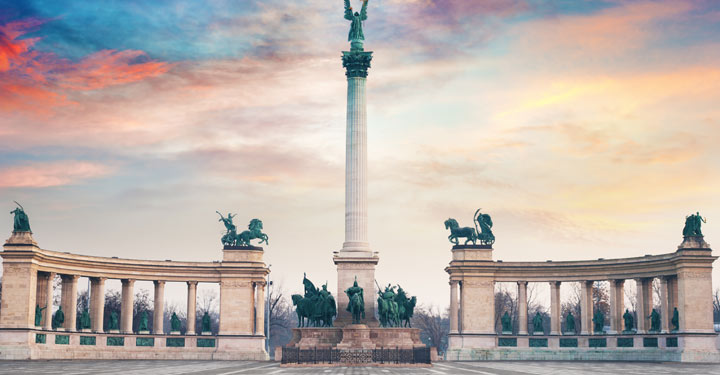
-
Category: monument
-
Date of construction: Erected for the 1896 Millenary Celebrations, but wasn't completed till 1929
-
Area of the colonnades: 85 meters by 25 meters
-
Height: the highest point of the monument is the 36-meter pillar
The Millenary Monument was erected for the 1896 Millenary Celebrations and the World Fair hosted in the City park. The monument consists of 3 different parts. In the center, we can see the 36m high pillar on which Gabriel the Archangel is standing. At the bottom of the pedestal are the chieftains of the seven Hungarian tribes, who led the conquest in 896 to the current territory of Hungary.
Behind them, there is a colonnade consisting of two semicircles. On each side, we find 7-7 statues of outstanding figures of Hungarian history, kings, and governors, and on the top of the colonnades, we can see the allegoric figures of work and welfare, war, peace, knowledge, and glory.
Some of the original statues of kings were replaced after WWII, allegedly because they were damaged. Curiously, only the statues of the Hapsburg kings and queen had to be removed, and they got replaced with outstanding figures from the anti-Hapsburg struggle of independence.
Before you head on, take a minute to look at the two buildings on the sides of the Heroes' sq: The Fine Arts Museum on your left and the Kunst Halle, Contemporary Art Museum on your right. If you like art, these are two of the top museums in Budapest.
The next top Budapest sight is just down the road on Andrassy Avenue. It will take you about 25-30 minutes in a comfortable pace if you want to walk it, but instead of walking, you can take a ride on continental Europe's oldest subway line: the millennium subway or, as you most likely see it on the map, the M1 or yellow line. The subway has charming vintage stations and runs with small yellow carts that are definitely worth a ride!
3. State Opera House

-
Category: Theater building
-
Construction 1875 - 1884
-
Area: 5383,200 m2
-
Architectural style: Italian neo-renaissance
As the Pest side was rapidly developing throughout the second half of the 19th century, Andrassy Avenue started transforming into the iconic high street that we know today. The Hungarian State Opera is the most important building on the avenue, but ironically was the cheapest plot of land--an outdoor flea market--before the construction began.
In 1873 the Emperor Franz Joseph I approved the building of the new opera house. Legend tells his only requirement was that the Budapest opera couldn't be bigger than the Viennese Opera House. But when on opening day he saw the building he said he should have said it couldn't be more beautiful.
The facade of the building is decorated by statues, including famous composers like Mozart, Beethoven, Liszt, Erkel, etc. and muses of dance, love, poetry, comedy, and tragedy. The inside of the building is decorated with countless paintings, frescos, and statues. The auditorium seats 1289 people, features a stage area of 634 sq meters, and had the most modern safety designs making it the most modern in the world at the time.
The building is open not only for opera lovers but you can also join building tours where you can visit the royal staircase, the Red Parlor (the royal guest hall leading to the royal box), and other areas normally inaccessible while attending the performances.
4. St. Stephen' Basilica
.jpg)
-
Category: a place of worship
-
Construction: 1851-1904
-
Area: 4147 sqm, Height 96 meters
-
Architectural style: neo-classical, neo-renaissance and neo-Baroque
St. Stephen's Basilica is the largest Roman Catholic church in the city. The name, in this case, refers to the title, Basilica Minor, which was granted to the church by the Pope in 1938.
In 1838 Budapest experienced a great flood and many people were able to survive this only by seeking refuge on the hill where the cathedral now stands. After the flood people wanted to thank God by building the largest church in the town.
There are two buildings in Budapest exactly 96 meters tall, one being the basilica and the other being Parliament. 96 meters represents the date 896 when the Hungarians settled in the Carpathian Basin, the current territory of Hungary. No building in the city is permitted to be taller than them.
Construction of the Basilica started in 1851 but due to some unforeseen circumstances it took more than 50 years. After the first architect died, a second took over just as the dome collapsed, then the entire church had to be demolished and started again. After all this, the second architect died too and a third was able to finally complete the work in 1905.
The constant setbacks in construction made Budapestians believe that the church would never be completed and this created a saying in Budapest: anytime you want to delay something you can say: "I'll do it when the Basilica is finished".
The church is named after the first king of the Hungarians, St. Stephen. He was canonized in 1083 because he converted the pagan, nomadic Hungarians to Christianity.
Normally in catholic churches as you enter you find a statue or a painting of Jesus or the Virgin Mary, but after getting special permission from the Pope in this church they stood St. Stephen's statue here. In the chapel of the Holy Right Hand, you can see an important relic, the right hand of St. Stephen.
The church is free to visit, but if you want to catch some breathtaking views over the city you can spend a couple of euros and visit the lookout point on the top of the dome. As I mentioned before, no building can be taller than the Basilica and the Parliament so this is one of the top viewpoints in Budapest!
The square front of the Basilica hosts one of the best Christmas markets in the city each year, with a gigantic Christmas tree and ice skating rink in the middle. At the stands, they offer artisanal food, drink, and handmade crafts, where you can undoubtedly find the right gifts for everyone (including yourself).
5. House of the Hungarian Parliament
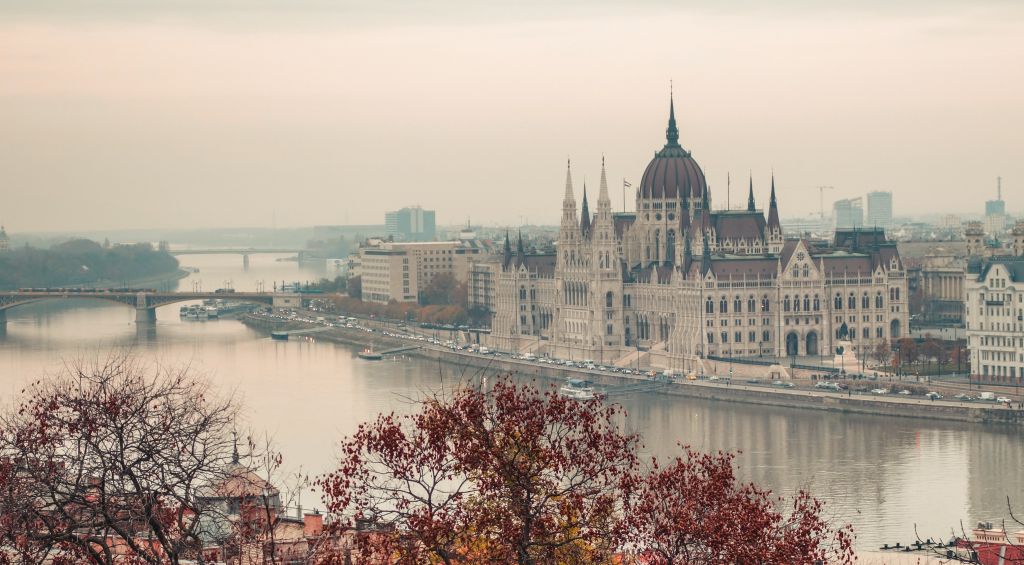
-
Category: Governmental Building
-
Construction: 1885 - 1904
-
Height and area: 17745,45 sqm: 268m long, 118m wide and 96m high
-
Architectural style: neo-gothic
The building was intended to be ready for the 1896 Millenary Celebrations but wasn't fully finished. They were able to hold the opening ceremony in the main hall, but construction wasn't fully completed until 1904.
The Parliament is the most expensive building that was ever built in Hungary: it features 691 rooms, 10 courtyards, 27 gates, 20km of staircases, 242 sculptures and 40kgs of 22carat gold decorating the inside.
The height of the building is an iconic 96 meters, which, as we mentioned before, represents the date 896 when the Hungarians settled here. At the time of its construction, it was the tallest parliament building in the world. Currently, it is the 3rd highest. To help you imagine it, it's 4 meters taller than Westminster Abby.
This is the only place on the earth where you can see three parliament buildings on one square. This is because in 1883 a competition was announced to design the building of the Hungarian Parliament. Many excellent designs were submitted and it was decided not just to build the first place winner as the building of Parliament, but the second and third place winners as well to serve as different governmental buildings right on the same square.
The Hungarian crown and crown jewels are displayed in the great Dome Hall since the year 2000, which you can visit by guided Parliament tours. The building tours are led in many different languages daily, but sell out in advance!
The front of the Parliament is facing the Danube, therefore the best way to get the full experience of it is to hop on a boat tour or boat party.
As you walk along the riverbank towards the chain bridge take a minute to stop at the "Shoes on the Danube", a world-famous holocaust memorial.
6. Széchenyi Chain Bridge
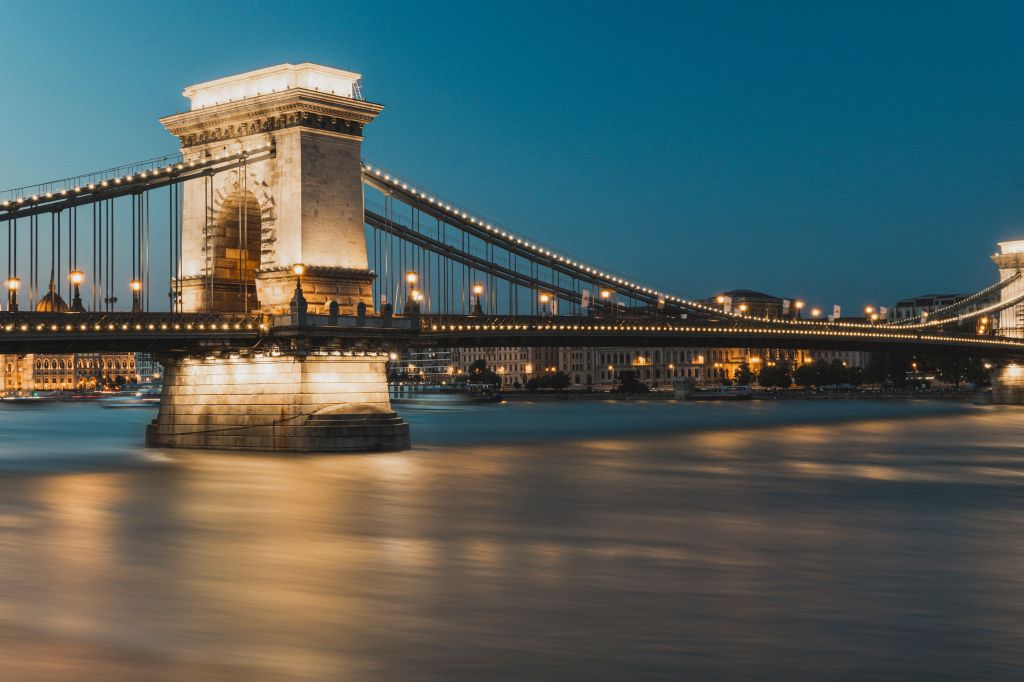
-
Category: Public space
-
Construction:1842 - 1849
-
Length: 375 meters
-
Style: Suspension bridge
As we mentioned before, the city of Budapest was created from the towns Buda, Pest, and Óbuda in 1873. One of the first steps that helped to unite the two sides of the river was the first permanent bridge: the Chain Bridge. (Currently under renovation)
What led to the building of the first permanent bridge? The story goes that Count Széchenyi Istvan, known as "the Greatest of the Hungarians" due to his many important deeds, couldn't attend his father's funeral, because the river was nearly frozen over and no boats were able to cross it.
After the tragedy, Széchenyi initiated the building of the bridge and it was designed by English engineer William Tierney Clark in 1839. At the time of its construction, the bridge was considered one of the modern world's engineering wonders.
Many, many local legends are associated with this treasured landmark--espcially connected to the lions "guarding" the bridge. Supposedly, the sculptor said if someone could find a flaw with them he would commit suicide. People examined every part of them but couldn't find a single fault, until a cobbler (a fairy tale hero in Hungarian folk tales) found that the lions have no tongues.
Allegedly, many people made fun of him for omitting this detail, so he visited a travelling zoo to show that you can't see their tongues normally. The artist insisted they do in fact have tongues, you just need to stand right opposite them to see.
The bridge is one of the most picturesque sights of the night sky in Budapest, along with the Parliament building. Make sure to take a nighttime stroll along the river bank or hop on a boat party.
Our next point of interest is already going to be on the Buda side. If you don't feel like walking across the bridge and climbing stairs to the castle district (approximately 20 minutes uphill) then this is the right place to hop on bus #16 and take it to "Disz Square" to find the next top sight of Budapest.
7. Matthias Church (Church of the Assumption of Buda Castle)
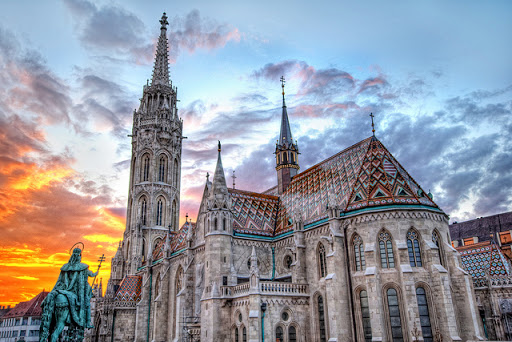
-
Category: a place of worship
-
First mentions of the church are referring to a church built here in 1015 AD, by St. Stephen but destroyed by the Mongolians
-
The current building was constructed in the second half of the 14th century and reconstricted in the 19th century
-
Height: 81m high
-
Architectural Style: originally built in romanesque style, current building late Gothic style
This is undoubtedly the most famous church of the Buda side. The church is reffered to by many names, but is most commonly known as Matthias Church. Not many people know - not even many Hungarians - that the church is actually officially called the Church of the Assumption.
Its colloquial name refers to our great king Matthias “The Just”. In his time, the church went through a large scale transformation and his crest can still be seen today on the so called Matthias Tower. Matthias was a just and great king, but has not been canonized, therefore no church can be named after him officially.
The church is used for coronations as well as for royal weddings, therefore the church is sometimes referred to as the Coronation Church of Buda as well.
Many legends are connected with the church as it has seen many centuries of Hungarian history. One of the most miraculous stories is the 1686 "Mary-wonder." During the Turkish occupation, the church was used as a mosque.
As the Holy League sieged Buda the wall of the church collapsed due to cannon fire and an old Virgin Mary statue was revealed in front of the praying Muslims. The city fell on the same day freeing Buda from the Turkish rule, they attributed their victory to the miracle.
Make sure to take a close look at the colorful roof--it is made with the world-famous Zsolnay tiles. The company introduced the eosin glazing process and pyrogranite ceramics, which are frost resistant, making them suitable for roof tiling. You will notice that many buildings in Budapest have the same roof tiles.
The interior of the church is spectacular and we highly recommend visiting it if your time allows. If you would like to see the church in a way that not many people do consider joining a bell tower tour.
8. Fisherman's Bastion

-
Category: Lookout point
-
Date construction started: 1895
-
Date construction ended: 1902
-
Length: 140 m
-
Architectural style: Romanesque revival
The Fisherman's Bastion was designed in 1895 as part of the large scale construction of the country's Millenary Celebrations. The Bastion has 7 tent-shaped towers that were built as a remembrance of our ancestors - the seven nomadic Hungarian tribes who settled here in 896.
The Bastion is purely decorative and never served nor was intended for military purposes. Its main function is as a lookout terrace over the Danube. There are two explanations for the origin of its name: One of the stories tells that in the middle ages there was a big fish market here, while the other one claims that the fisherman's guild was responsible for defending this part of the city in case of an attack.
As the castle district can be rather crowded in the daytime, come back for the perfect picture in the morning or around sunset. The pillars and "windows" of the structure serve as a beautiful frame for any shots taken of the Pest side.
9. The Royal Palace of Buda
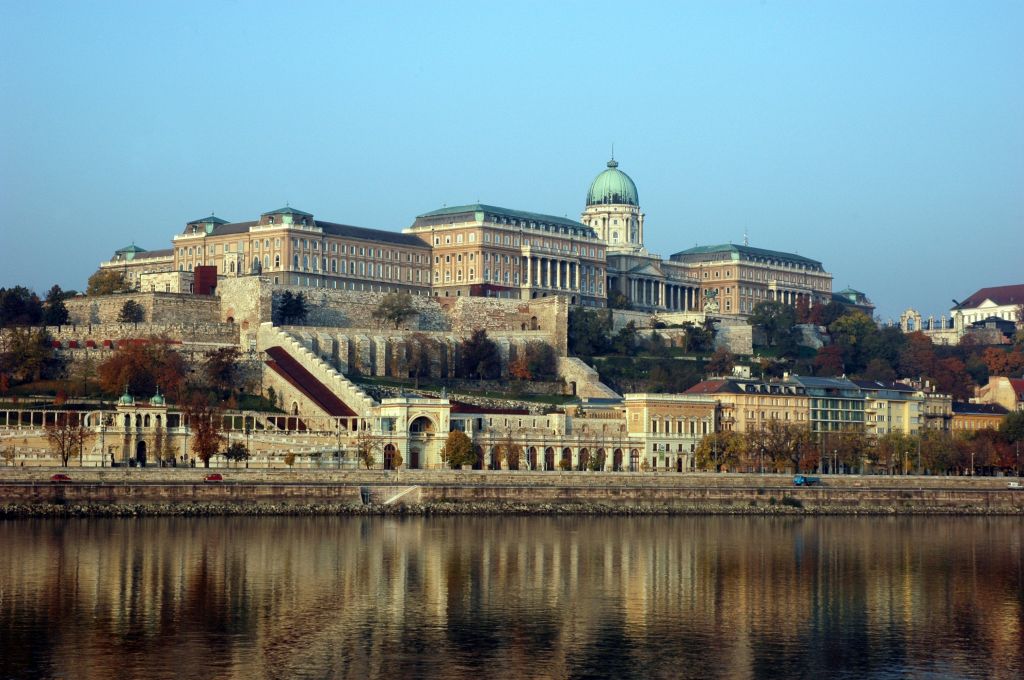
-
Category: Historical building
-
The first royal residence on this site dates back to the 13th century
-
The castle was constantly reconstructed and expanded throughout history, currently parts under reconstruction
After the Hungarians settled the territory that would become Budapest, the first royal residence was constructed on the northern side of the castle district. However, soon after the Mongolian invasion, they realized that the southern side of the hill was more easily defendable. So the king moved the court to where the royal palace now stands.
As one king followed the other, the castle was constantly under reconstruction and expansion, and throughout the ages it changed architectural styles many times. If you want to get to know the many faces of the royal palace of Buda I highly recommend the Buda History Musem which you can enter from the inner courtyard of the palace.
The royal palace was damaged in WWII, and even though the damages were reparable the socialist government paid no attention to the building as it represented the Hapsburg monarchy, a system that they opposed.
The damage to the roof allowed water and other elements to slowly destroy the inside of the palace and by the time of its reconstruction very little could be saved. The inside of the palace is now used as two museum buildings: The Hungarian National Gallery and, the previously mentioned, Buda History Museum.
As you walk around you can notice that the castle district, mostly surrounding the palace, has many building sites. The government decided to rebuild buildings, demolished after WW II., based on their original blueprints. Thanks to this project the garrison and the royal riding hall are nearly completed and will function as restaurants and event spaces.
10. Gellért Hill and Statue of Liberty
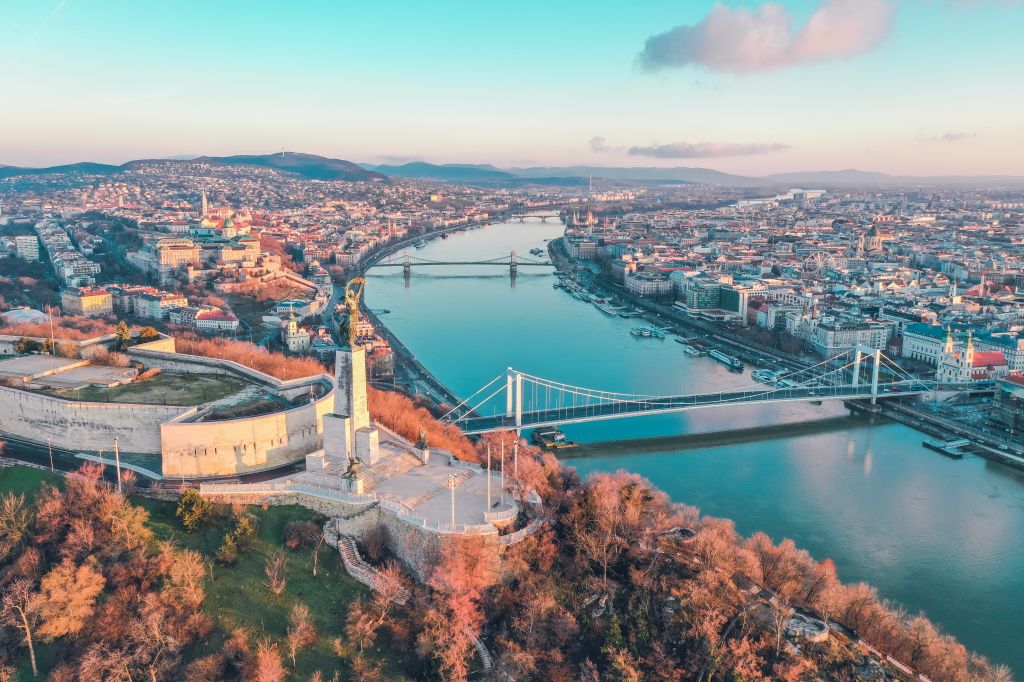
-
Category: lookout point and monument
-
Citadel built: 1851-1854
-
Liberty statue erected: 1947
-
Hill height 235 m, Liberty statue: 26m pedestal and 14 m tall bronze statue
If you still have some energy left then it's time to climb the second-highest hill in Budapest to visit the #1 lookout point in Budapest. Don't worry - even though it's the second-highest spot you can climb it in about 20 minutes.
There are many different ways to get up there - some are steep and fast, some are more roundabout but gently escalating – but all route options offer you plenty of rest stops (and in the wintertime vendors sell heart-warming mulled wine along the way). If you would rather take public transportation, take any tram or bus going to Moricz Zsigmond Korter (almost all of the transportation with a stop at the bottom of the castle will also stop at Moricz) and from there take bus #27.
The hill was known to people long before the Hungarians. Streams and springs of thermal water run under Budapest, creating warm caves where people were able to take refuge in the harsh winter months and many before us enjoyed the thermal water itself.
The hill wasn't populated in the middle ages, but some legends tell about it being a gathering point of witches to perform their ceremonies. Until the 18th century Gellért Hill did not see much action apart from the vineyards that covered its sides.
The hill is named after Bishop Gellért, whose statue is standing at the side of the hill. There is a famously gruesome legend connected with his name. As the pagan Hungarians settled in Europe the question arose among the country's leaders whether Europe will accept the newcomers or if they would need to convert to Christianity.
After many fights and inner intrigues in the royal family, St. Stephen was elected as the first Christian king, crowned with a crown sent by the Pope. He instated many regulations to ensure that Hungarians would become good Christians--but this didn't go smoothly.
Bishop Gellért came to the country to be the educator of the king's son, but angry pagans captured and assassinated him. They placed him into a barrel full of nails and rolled him down the side of the hill into the Danube to signal that they wouldn't give up their faith.
As you climb up to the top of the hill, depending on the route you choose you might see the cave church or hidden communist statues. The hill is full of surprises so you can walk around it many, many times and still find something new.
On top of the 235 meters high hill you can find the Citadel, the Statue of Liberty, and the terrace in front of them which undoubtedly serves as Budapest's top lookout point.
The Citadel was built after the anti-Hapsburg uprising of 1848–49, as it was an important strategic site for controlling both Buda and Pest. Later, one wall of the citadel was demolished as a symbolic sign that its military significance ceased to exist.
Unfortunately, in 1956 Soviet troops decided to use the citadel once again for military purposes and fired onto the uprising Hungarians. Since 2014 the fortress itself is closed to visitors, but you can visit it from the outside and enjoy the spectacular views.
The Liberty Statue was erected by the Soviets to commemorate the Soviet military forces who freed Budapest from the Nazi occupation. The statue is the symbol of Budapest, but many Hungarians have mixed feelings about it as it was originally stood to honor the Soviets.
The inscription on the base originally read "To the memory of the liberating Soviet heroes [erected by] the grateful Hungarian people [in] 1945" but was later modified to "To the memory of those all who sacrificed their lives for the independence, freedom, and prosperity of Hungary".
Even though this list only scratches the surface of what Budapest has to offer, you can use these top 10 sights to see in Budapest as a way to guide your Budapest adventure! Where will you start?
Related Articles


